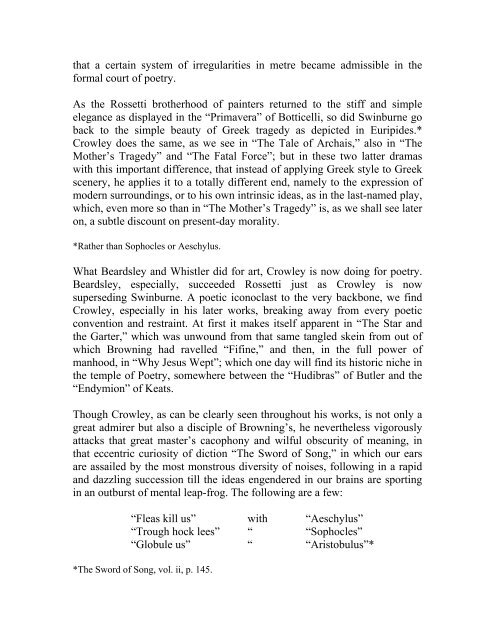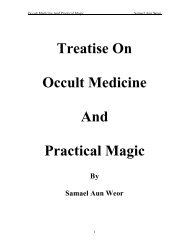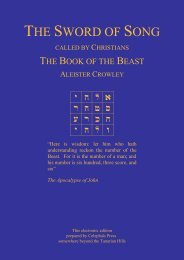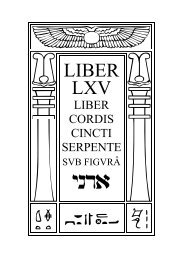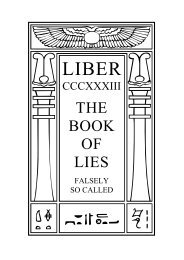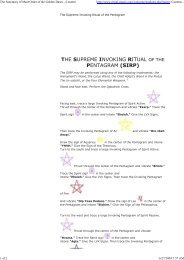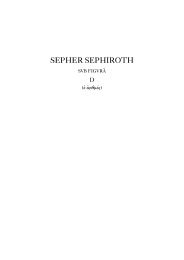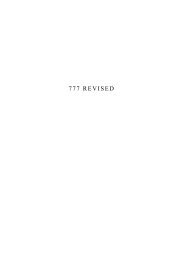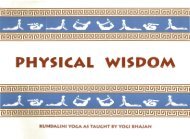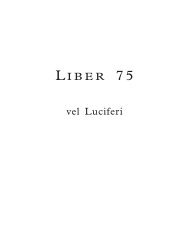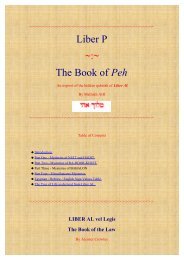Star In the West TNR.pdf - The Hermetic Library
Star In the West TNR.pdf - The Hermetic Library
Star In the West TNR.pdf - The Hermetic Library
You also want an ePaper? Increase the reach of your titles
YUMPU automatically turns print PDFs into web optimized ePapers that Google loves.
that a certain system of irregularities in metre became admissible in <strong>the</strong><br />
formal court of poetry.<br />
As <strong>the</strong> Rossetti bro<strong>the</strong>rhood of painters returned to <strong>the</strong> stiff and simple<br />
elegance as displayed in <strong>the</strong> “Primavera” of Botticelli, so did Swinburne go<br />
back to <strong>the</strong> simple beauty of Greek tragedy as depicted in Euripides.*<br />
Crowley does <strong>the</strong> same, as we see in “<strong>The</strong> Tale of Archais,” also in “<strong>The</strong><br />
Mo<strong>the</strong>r’s Tragedy” and “<strong>The</strong> Fatal Force”; but in <strong>the</strong>se two latter dramas<br />
with this important difference, that instead of applying Greek style to Greek<br />
scenery, he applies it to a totally different end, namely to <strong>the</strong> expression of<br />
modern surroundings, or to his own intrinsic ideas, as in <strong>the</strong> last-named play,<br />
which, even more so than in “<strong>The</strong> Mo<strong>the</strong>r’s Tragedy” is, as we shall see later<br />
on, a subtle discount on present-day morality.<br />
*Ra<strong>the</strong>r than Sophocles or Aeschylus.<br />
What Beardsley and Whistler did for art, Crowley is now doing for poetry.<br />
Beardsley, especially, succeeded Rossetti just as Crowley is now<br />
superseding Swinburne. A poetic iconoclast to <strong>the</strong> very backbone, we find<br />
Crowley, especially in his later works, breaking away from every poetic<br />
convention and restraint. At first it makes itself apparent in “<strong>The</strong> <strong>Star</strong> and<br />
<strong>the</strong> Garter,” which was unwound from that same tangled skein from out of<br />
which Browning had ravelled “Fifine,” and <strong>the</strong>n, in <strong>the</strong> full power of<br />
manhood, in “Why Jesus Wept”; which one day will find its historic niche in<br />
<strong>the</strong> temple of Poetry, somewhere between <strong>the</strong> “Hudibras” of Butler and <strong>the</strong><br />
“Endymion” of Keats.<br />
Though Crowley, as can be clearly seen throughout his works, is not only a<br />
great admirer but also a disciple of Browning’s, he never<strong>the</strong>less vigorously<br />
attacks that great master’s cacophony and wilful obscurity of meaning, in<br />
that eccentric curiosity of diction “<strong>The</strong> Sword of Song,” in which our ears<br />
are assailed by <strong>the</strong> most monstrous diversity of noises, following in a rapid<br />
and dazzling succession till <strong>the</strong> ideas engendered in our brains are sporting<br />
in an outburst of mental leap-frog. <strong>The</strong> following are a few:<br />
“Fleas kill us” with “Aeschylus”<br />
“Trough hock lees” “ “Sophocles”<br />
“Globule us” “ “Aristobulus”*<br />
*<strong>The</strong> Sword of Song, vol. ii, p. 145.


